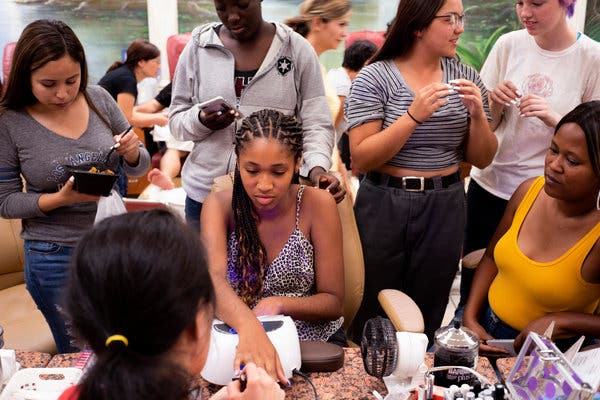Jayla Sheffield, 15, looked to her left and right. She and six friends, all wearing black shorts, white Nikes and T-shirts with the words “Jayla’s Quince,” paused, ready to kick off a night of festivities with a dance routine they had practiced for months.
The occasion, which brought over 100 people together in Pomona, Calif., was what Jayla and her mother, Miranda Sheffield, were calling a “quincenegra” — a term they adopted to honor Jayla’s Afro-Latina background as well as the traditional coming-of-age customs of a classic quinceañera.
Jayla gave a final nod, and the girls flung out their arms and started a hip-hop dance medley. It featured fluid twists and turns, set to pop songs by Cardi B and Bruno Mars along with punta music from Honduras, where Jayla’s father was born.

Quinceañeras like Jayla’s are an integral part of the experiences of young women in Latin America and throughout the United States. They signal a celebratory moment in the lives of teenage girls and, in many families, are seen as a necessary rite of passage.
They are also events that tend to be steeped in generational layers of tradition. They have unspoken dress codes (white or brightly colored dresses for the birthday girl); set gender distinctions (the chambelán, whose job is to escort and dance with the quinceañera, is almost always a young man); and established rituals, both religious and secular (Mass before the party; waltzing at the party).
But there is a growing generation of Latinos and Latinas who are choosing to redefine what quinceañeras mean, eschewing some of the old rules and expanding the purpose of the event.
It is now more common to see quinces as celebrations of identity, including for queer and transgender individuals, and quinces that honor more than the transition to adulthood.
Double quinces, for example, which are held by those turning 30, are being celebrated by an increasing number of people who may not have been able to afford a quinceañera at age 15, or who would rather celebrate womanhood once they are firmly in it.
For Jayla, the quinceañeara was an occasion to celebrate blackness and black womanhood. “Most of my family is black, and I’ve mostly only always been around them,” she said while getting her nails done with her friends a day before the big day. “I wanted all of that to come out in my party, and I also wanted drums and food that honored my Afro-Latina heritage.”
In Bakersfield, Calif., on the same day as Jayla’s quince, Amina Shareef Hamza, 14, had a quinceañera that honored her Muslim faith. Underneath her embroidered black dress she wore a long-sleeve shirt to cover her arms, and she ditched the tradition of having a chambelán and celebrating a Catholic Mass.
Amina, whose father is Egyptian and whose mother is of Guatemalan, Honduran and Native American descent, is part of a horse riding club that competes in escaramuza, a form of traditional Mexican riding and performance done only by women.
So she incorporated that too, appearing at the beginning of the ceremony astride her mother’s horse Chispa. “My dad speaks Arabic and my mom speaks to me in Spanish,” she said. “It’s a taste of both worlds.”
Amina’s mother, Leslie Henderson Oaxaca, converted to Islam in her early 20s, but she grew up in a Catholic family in Long Beach, Calif. She never had a quinceañera of her own, so she had a special devotion to Amina’s.
“This quince isn’t just about me. It’s about our three generations,” Ms. Oaxaca said. “My mom came here in the ’70s and she cleaned houses and went through hell for us, and now she gets to see her granddaughter’s quince. It’s really special.”
Ms. Oaxaca is a single mother, but the wishes of Amina’s father did weigh heavily on how the quince would look and feel. “Her father didn’t want her showing any skin, for religious reasons,” Ms. Oaxaca said. Still, the incorporation of a religion apart from Catholicism felt like a break from the norm.
“This generation is breaking down all of the tradition,” Ms. Oaxaca said. “They are doing their own traditions.”
Helly Toscano, 26, a family friend from Bakersfield who attended the quince, agreed. “My dad is Yemeni and my mom is Mexican, and I wasn’t able to celebrate both sides when I was younger,” she said, while taking photos of Amina on the horse. “I think more people like her are breaking the norm, and I respect her dress and the way she covered up.”
Amina’s generation is “more persistent,” Ms. Toscano said, and “their voices are louder and being heard.”
Quinceañeras are becoming a distinct way to create belonging in the United States, said Stephanie Canizales, a postdoctoral scholar at the University of California Merced, who studies Latino immigration and youth.
“Quinceañeras, like other Latinx celebrations in the U.S., are important for a positive identity and space in a political moment where Latinxs are constantly portrayed as social deviants with no place to belong,” she said.
“In the U.S. context, quinceañeras are also a bridge to home country traditions and offer a way of connecting the U.S.-born second generation to the world parents left behind,” Professor Canizales said.
These quinces, both of them private affairs, were, in a larger context, products of shift and change within the Latino community in the United States.
“The changing nature of quinceañeras point to an exciting diversification of the Latinx landscape,” Professor Canizales said. “There is no one-size-fits-all quinceañera celebration. This means there is no one Latinx — and that’s a beautiful landscape.”







